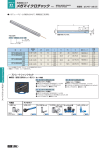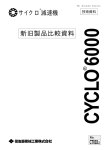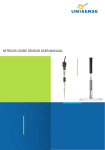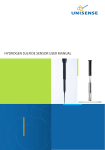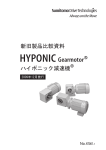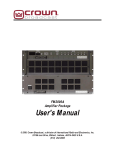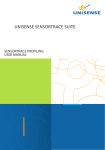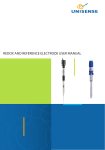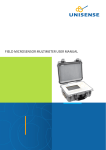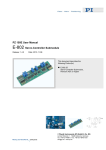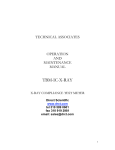Download DIFFUSIVITY SENSOR USER MANUAL
Transcript
DIFFUSIVITY SENSOR USER MANUAL Transducer Gas reservoir Membranes 1 Diffusivity sensor user manual Copyright © 2011 · Unisense A/S Version October 2011 DIFFUSIVITY SENSOR USER MANUAL UNISENSE A/S TABLE OF CONTENTS WARRANTY AND LIABILITY . . . . . . . . . . . . . . . . . . . . . . . . . . . . . . . . . . . . . . . . . . . . . . . . . . . 8 CONGRATULATIONS WITH YOUR NEW PRODUCT! . . . . . . . . . . . . . . . . . . . . . . . . . . . . 9 Support, ordering, and contact information 9 OVERVIEW . . . . . . . . . . . . . . . . . . . . . . . . . . . . . . . . . . . . . . . . . . . . . . . . . . . . . . . . . . . . . . . . . . . 11 GETTING STARTED . . . . . . . . . . . . . . . . . . . . . . . . . . . . . . . . . . . . . . . . . . . . . . . . . . . . . . . . . . 12 Unpacking a new sensor Polarization Connecting the microsensor Pre-polarization Supply tracer Calibration 12 12 12 12 13 14 GENERAL USE OF THE DIFFUSIVITY SENSOR . . . . . . . . . . . . . . . . . . . . . . . . . . . . . . . . . 17 Measurements Interference 17 17 STORAGE AND MAINTENANCE . . . . . . . . . . . . . . . . . . . . . . . . . . . . . . . . . . . . . . . . . . . . . . 18 Transportation 18 REFERENCES . . . . . . . . . . . . . . . . . . . . . . . . . . . . . . . . . . . . . . . . . . . . . . . . . . . . . . . . . . . . . . . . . 19 TROUBLESHOOTING . . . . . . . . . . . . . . . . . . . . . . . . . . . . . . . . . . . . . . . . . . . . . . . . . . . . . . . . 20 WARRANTY AND LIABILITY Notice to Purchaser This product is for research use only. Not for use in human diagnostic or therapeutic procedures. Warning Microsensors have very pointed tips and must be handled with care to avoid personal injury and only by trained personnel. Unisense A/S recommends users to attend instruction courses to ensure proper use of the products. Warranty and Liability The diffusivity sensor is covered by a 60 days limited warranty. Microsensors are a consumable. Unisense will only replace dysfunctional sensors if they have been tested according with the instructions in the manual within 14 days of receipt of the sensor(s). The warranty does not include repair or replacement necessitated by accident, neglect, misuse, unauthorized repair, or modification of the product. In no event will Unisense A/S be liable for any direct, indirect, consequential or incidental damages, including lost profits, or for any claim by any third party, arising out of the use, the results of use, or the inability to use this product. Unisense mechanical and electronic laboratory instruments must only be used under normal laboratory conditions in a dry and clean environment. Unisense assumes no liability for damages on laboratory instruments due to unintended field use or exposure to dust, humidity or corrosive environments. Repair or Adjustment Sensors and electrodes cannot be repaired. Equipment that is not covered by the warranty will, if possible, be repaired by Unisense A/S with appropriate charges paid by the customer. In case of return of equipment please contact us for return authorization. For further information please see the documents Conditions for Sale and Delivery for Unisense and Warranty and Shipping Information as well as the manuals for the respective products. 6 CONGRATULATIONS WITH YOUR NEW PRODUCT! Support, ordering, and contact information If you wish to order additional products or if you encounter any problems and need scientific/technical assistance, please do not hesitate to contact our sales and support team. We will respond to your inquiry within one working day. E-mail: [email protected] Unisense A/S Tueager 1 DK-8200 Aarhus N, Denmark Tel: +45 8944 9500 Fax: +45 8944 9549 Further documentation and support is available at our website www.unisense.com. REPLACEMENT OF SENSORS Unisense will replace sensors that have been damaged during shipment provided that: • The sensors were tested immediately upon receipt in accordance with the delivery note and the manual • The seal is still intact. • The sensors are returned to Unisense for inspection within two weeks. • The sensors are correctly packed for return to Unisense, in accordance with the note included in the sensor box. 7 RECOMMENDED AMPLIFIERS One-channel amplifier: Microsensor Monometer Multi-channel amplifier: Microsensor Multimeter 8 OVERVIEW The Unisense diffusivity microsensor DF50 is based on a unique principle, which allows apparent diffusivity measurements to be performed at the very tip of a sensor with a tip diameter of 20-500 microns. The sensor is applicable within environmental sciences and related areas. WARNING Unisense sensors are neither intended nor approved for use on humans With its minute tip size the Unisense diffusivity microsensors facilitate reliable and fast diffusivity measurements of a high spatial resolution. The Unisense diffusivity microsensor is a based on a miniaturized amperometric micro-transducer surrounded by a closed tracer gas reservoir with a tip membrane. The diffusive loss of tracer gas through the membrane-filled tip of the microsensor, results in a linear decrease in partial pressure of the tracer gas across the membrane and a hyperbolic decrease throughout the diffusion sphere of the surrounding medium. In a medium with a relatively high diffusion coefficient e.g. stagnant water, a relatively strong partial pressure gradient builds up across the membrane, causing a relatively low reading by the gas transducer mounted with its detecting tip embedded in the membrane close to the surrounding medium. In contrast, a low diffusion coefficient, as in a low porous sediment, impedes the diffusive loss from the sensor tip and increases the partial pressure of the tracer gas at the sensing tip and results in a higher signal from the tracer gas transducer. The signal can be calibrated to measure apparent diffusivity = porosity Transducer * diffusion coefficients. For operation the diffusivity Gas reservoir microsensor must be connected to a picoammeter (e.g. the Microsensor Monometer). Schematic view of the tip of a Membranes diffusivity sensor. 9 GETTING STARTED Unpacking a new sensor When receiving a new microsensor remove the shock-absorbing grey plastic net. Secure microsensor shaft in micromanipulator or other holder. Polarization The signal from the diffusivity sensor is generated in picoampere. Therefore the sensor must be connected to a polarizing picoammeter (e.g. a Microsensor Monometer, a Microsensor Multimeter, or the Unisense PA2000). Diffusivity sensors should be polarized at +1000 mV. The polarization voltage is set in the amplifier. For details on how to set and check the polarization, consult the user manual of the amplifier you are using. If you are using a PA2000 amplifier, please check the polarization voltage before connecting the sensor, since incorrect polarization may destroy the sensor. Connecting the microsensor Connect the LEMO connector to the input terminal. The LEMO connector contains connections for both reference electrode and sensing anode. Pre-polarization When the sensor is not in use, H2 will build up inside the electrolyte of the hydrogen transducer. This must be removed in order to obtain a stable zero current as background for calibrations and measurements. Therefore, a period of polarization is necessary before you can use the sensor. This is called the pre-polarization period. Just after connecting the sensor, the signal will be very high and 10 WARNING Do not remove seal and protective plastic tube before these steps are successfully completed. WARNING Incorrect polarization may destroy the sensor. then drop rapidly over the first few minutes. After that the signal will drop slowly for up to 1 hour. If the sensor is new or has not been operated for several days, it must be polarized for at least 1 hour before it can be calibrated and used. After shorter periods without polarization, the sensor should be polarized until it has exhibited a stable signal for 10 minutes. The signal depends on the specific sensor (see the value in the specifications that came with the sensor). If the signal does not stabilize or is too high or too low, refer to the ‘Trouble-shooting’ section of this manual. Supply tracer If the diffusivity microsensor is of the flow-through type, connect a tracer source to one of the steel capillaries. The tracer source is a tank of suitable tracer gas with an outlet valve, which leads the tracer through a soft tube. By inserting a T-piece with a side-tube, which opens at the bottom of a beaker of water, a suitable pressure can be obtained by adjusting the outlet flow from the tracer tank to a level just under the point when bubbles appear from the side-tube. It is generally best to minimize the length of the tubes used in the setup (2-3m). If the sensor is of the closed reservoir type with a refill system, refill the reservoir. The refill system consists of two glass tube inlets with a silicone septum and sealed with wax, closing the two steel capillaries of the tracer reservoir. To refill the reservoir, proceed as follows: The wax in each inlet is punctured by ‘drilling’ through it with a 0.5-mm syringe needle proceeding slightly into the silicone membrane. After drilling both wax plugs, a fresh 0.5-mm syringe needle (the ‘drill’ needle will be clogged) is carefully inserted through the drill hole of each wax plug and pushed through the silicone membrane. A dry 20-ml syringe is filled with the desired tracer (e.g. 100% hydrogen) from a tracer source. The tracer must be dry. The syringe is attached to the needle in one of the inlets. Atmospheric contamination of the tracer in the syringe during transfer can be avoided by keeping the nozzle blocked when possible and by releasing a small tracer flow through the nozzle when it is not blocked. When the syringe is attached to the needle, 11 the tracer is slowly injected. Make sure that the reservoir is actually flushed by observing a tracer stream leaving through the needle in the other inlet. This can be observed by feeling the gas stream against the eye or by observing bubbles when a soap-covered finger is held lightly against the top of the needle. Be careful not to introduce moisture into the reservoir! When the reservoir has been flushed with at least 10 ml of the tracer, remove the syringe and the attached needle, then remove the needle in the other inlet. The silicone membrane will now keep the tracer inside the reservoir, but to make the final gas-tight seal, the wax plugs must be re-melted. This is done by heating a metal object (e.g. the tips of a pair of pliers) and holding it against the outside of the glass inlet, just long enough for the wax to become clear and liquid. When the wax hardens again, the refill is completed. Place a beaker of water under the sensor, and immerse the sensor tip by lowering the sensor or raising the water. This should cause the signal to increase (numerically). When moving the water from side to side the signal should decrease. If the sensor responds consistently in this fashion, it is functioning correctly. Carefully remove the seal and the protective glass tube before making calibrations and measurements. Calibration Calibration must be performed after the signal has stabilized during pre- polarization. If you use a strip chart recorder or other data acquisition device, connect this to the output connections of channel 1 of the PA2000. If the required polarity of the data acquisition device is opposite to the output of the PA2000, swap the plus and minus connections of the output terminals. A two-point calibration must be performed in two media of known diffusivity (e.g. stagnant water, and a sedimentary material with known diffusivity). The diffusivity microsensor is placed in a calibration setup. A calibration setup can consist of a device (e.g. micromanipulator) that allows the sensor tip to be immersed in the calibration vial supplied by Unisense or a similar vial. The vial must be partially filled with a medium of known diffusivity (e.g. glass beds of uniform size supplied by Unisense) and have 12 IMPORTANT Always use a calibration solution similar to the sample solution regarding temperature and salinity an overlaying stagnant water phase. Adjust the height of the sensor until the tip is in the overlaying stagnant water. Allow the sensor signal to stabilize. This is your first calibration point. Insert the sensor into the calibration material by lowering the tip slightly, and make sure the tip is completely immersed in the material. Allow the sensor signal to stabilize. This is you second calibration point. The readings are used to produce a calibration curve, through which a measured signal can be converted into an apparant diffusivity. The signal response in a given medium is a function of φDs (porosity and diffusion coefficient) which can be described as: Sm = α φmDm + β (1) or φmDm = α Sm -β (2) The two parameters α and β depend solely on sensor characteristics and can be estimated with the simple two point calibration of the sensor where the diffusion coefficient in medium 1 (apparent diffusivity φD1) yields signal (S1) and diffusion coefficient in medium 2 (apparent diffusivity φD2) yields signal (S2). By combining equation 1 and 2, the diffusion coefficient in the measuring medium φDm can be expressed as a function of the measured signal Sm: (S2 - Sm) S1φ1D1 - (S1- Sm) S2φ2D2 φmDm = Sm (S2- S1) IMPORTANT: small dust particles and for instance calibration glass beds may adhere to the diffusivity microsensor tip and strongly influence the signal. If particles adhere, remove them by carefully brushing the tip with a very fine paintbrush (the finest type that can be bought for art painting). The brush is preferably mounted under water with its hairs pointing up; the sensor tip is cleaned by moving it back and forth with the micromanipulator controls through the tips of the brush hairs. If you touch the tip with coarser parts of the brush, the sensor may break. Check 13 and repeat calibration at appropriate intervals to ensure that all measurements can be calibrated to correct diffusivities. To minimize the need for calibrations, keep the sensor polarized between measurements, unless the time between measurements exceeds several days or unless the picoammeter batteries are running out. The gas permeability of diffusivity microsensor membranes changes with time, so a change in signal of up to 50% may occur over months. If the sensor functions according to these description, carefully remove the seal and the protective plastic tube before making measurements. 14 GENERAL USE OF THE DIFFUSIVITY SENSOR Measurements Some solid materials can be penetrated with the tip of the diffusivity sensor, e.g. soft silicone rubbers, soft tissues etc., But due to the small size of the diffusivity microsensor tip and the steepness of diffusivity gradients in many environments, even a displacement of the sensor tip of a few microns may change its immediate diffusivity environment. Furthermore, coarse lateral movements of the sensor when its tip is in contact with a solid substrate can easily cause the tip to break. Therefore measurements should be performed only in a stabilized setup fixed on a sturdy table free of moving or vibrating devices. The signal of the microsensor is very small (10-13 to 10-10 ampere). Although both suitable picoammeters like the PA2000 and the Unisense diffusivity microsensors are very resistant to electrical noise from the environment, electrical fields may interfere with the sensor signal. Minimize this by turning off unnecessary electrical and mechanical equipment and by not touching the sensor or wires during measurements and signal recording. Interference Exposure to high concentrations of sulfide should be avoided as it may interfere with the signal of the hydrogen sensor and can cause irreversible damage to the diffusivity sensor. On suspicion of sensor damage, repeat calibration and consult ’Troubleshooting’. 15 STORAGE AND MAINTENANCE Store the sensor in the protective glass tube used for shipping. The diffusivity microsensor should be stored with the tip exposed to air. The room in which the diffusivity microsensor is stored should be dry and not too hot (10-30°C). Transportation Mechanical shock should be avoided. Use the appropriate sensor box in which you received the sensor from Unisense. 16 REFERENCES Revsbech N.P., Nielsen L.P., Ramsing N.B. 1998. A novel microsensor for determination of apparent diffusivity in sediments. Limnology and Oceanography 5:986-992. 17 TROUBLE SHOOTING Problem Possible cause Solution Problem Possible cause Solution Problem The calibration response has changed. A disturbing object is adhered to the sensor tip. Carefully brush the sensor tip with a very fine brush, preferably under water (see section on Calibration). If the deposits consist of grease, rinse with ethanol before brushing. A high and drifting signal. Gas bubbles are present inside the micro-transducer tip due to short circuit or electrical shock. Produce degassed water by boiling and subsequent cooling or by 10 minutes of vacuum treatment. Immerse the sensor tip for 20 min in the degassed water. Repeated or prolonged treatment may be necessary. The microsensor tip is broken Possible cause Solution Replace the flow microsensor. Problem The signal is very low. Possible cause Solution Problem Possible cause Solution Contamination of the cathode surface (e.g. by sulfide) or loss of anode material due to excessive vibrations. Replace the flow microsensor. Signal is unstable or fluctuates when the set-up is touched or equipment is introduced in the measurement medium. Electrical disturbance of the sensor through the membrane Ground the set-up by connecting the provided blyue grounding with the measurement medium. (If you are measuring in e.g. a sediment, just put the open wire end in the water column). If you encounter other problems and need scientific/technical assistance, please contact [email protected] for online support (we will answer you within one workday) 18 Unisense, Denmark www.unisense.com · [email protected]























